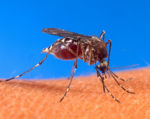| Also known as: | Mosquitoes |
| DO NOT CONFUSE WITH | Culicoides midges |
Members of the Culicidae family are found accross the globe and a attack a wide variety of different species. They holometabola and have four stages to their life cycle; egg, larva, pupa and adult. The species of greatest veterinary importance are;
- Culex
- Aedes
- Anopheles
Identification
Culicidae flies like all insects have 3 pairs of legs and like all Diptera order flies have only a single set of wings and vestigal set of 'halters'. They are small flies, between 2 and 10mm long with a slender body and legs. They consist of a head, thorax and abdomen and have a forward facing pobosic used for feading that protrudes from the head. The wings of Culicidae flies are narrow and fringed with scales at the rear margins.
Life Cycle
The life cycle of Culicidae flies is holometabolous meaning that they have a number of disticnt morphological states. The initial stages require areas of standing water in which to develop. The life cycle of these flies my take anywhere from two weeks to several months dependant on envirnmental conditrions, principaly the temperature.
Eggs
The eggs of Culicidae flies must be laid on areas of standing water such as buckets or ponds. They are laid either singularly or in rafts.
Larva
The larval stages are aquatic free living stages living close to the surface of standing water and feeding off the algae in the surface layer of the water. They can be seen hanging from the surface but may move deeper into the water if it is disturbed. The larval stage goes through several moults before it pupates.
Pupa
The pupal stage of Culicidae flies is also aquatic and hangs from the surface of standing water.
Adult
The adult fly emerges from the pupa after a number of days and is the only non aquatic stage of the life cycle. Both the male and female are nectar feeders, however in order to provide the nutrients for producing eggs the female must take a blood meal.
Pathogenesis
- Most active at night
- Painful, irritating bites
- Only females suck blood
- Transmit human diseases
- Viruses such as dengue fever, encephalitis and yellow fever
- Parasites such as malaria caused by Plasmodium and filarial nematodes which cause elephantosis (Wuchereria and Brugia)
- Transmit animal diseases
- Viruses such as arbovirus which causes equine encephalitis and rabbit myxomatosis
- Parasites such as the canine heartworm, Dirofilaria immitis and avian malaria caused by Plasmodium
Control
- Destroy breeding sites by drainage and removal of objects which collect water
- Repeat applications of insecticides
- Synthetic pyrethroids sprayed from helicopters
- Mineral oils applied to breeding sites
- Education
- Future control methods being developed, such as genetic engineering and biological control methods
